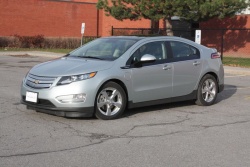 2012 Chevrolet Volt. Click image to enlarge |
| More Chevrolet Volt reviews on Autos.ca
Manufacturer’s web site |
By Chris Chase and Paul Williams; photos by Chris Chase
Photo Gallery:
2012 Chevrolet Volt
Ladies and gentlemen, we’d like to introduce you to the beginning of the end of gas-electric hybrid passenger vehicles as we know them. The 2012 Chevrolet Volt is something of a marvel on the road. There’s no other car quite like it, and General Motors is to be congratulated for moving from concept to reality in double-quick time. After receiving numerous awards and accolades, as GM says, “the Volt is in a class by itself.”
It’s not a hybrid, says the company, because its driven wheels are always powered by electricity. But you have to hang on tight to this position because the Volt certainly uses a combination of gasoline and electricity as fuel, via a gasoline engine and electric motor for motive power. From our perspective, a hybrid, by definition, is just this type of combination.
GM’s take is that the Volt is both a plug-in hybrid vehicle (PHEV) and electric vehicle (EV). It’s pushing for “Electric Vehicle with Extended Range” (EVER?). Chevrolet calls this method of propulsion the Voltec system.
But labels aside, the Volt certainly can run for usable distances on electricity alone, after you’ve charged its 400-pound lithium-ion battery. If you exceed the battery’s charge, the system switches seamlessly to gasoline as its source of energy, operating pretty much as a “normal” hybrid, except that unlike the Toyota Prius, for example, the wheels are never driven directly by the gasoline engine.
We’ve have heard the Nissan Leaf described as the best new vehicle your money can buy, period. The journalist who expressed that opinion is right, in the sense that it breaks ground and sets the market up for more electric vehicle (EV) competition. That, in turn, will lead to improvements in the technology, bring prices down, and make EVs more accessible to all (again, more on that later).
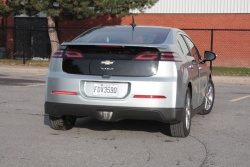 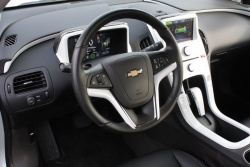 2012 Chevrolet Volt. Click image to enlarge |
But in terms of current-day personal transportation, the Leaf’s only flaw is its 160-kilometre range, which limits it to city driving. That’s not a bad thing, necessarily, but a driver who needs a vehicle for highway trips will need to either own a second car (which many families do) or rent one as needs dictate. The Volt’s advantage is that its gas engine allows the car to be operated outside of the typical EV envelope: battery runs out, gas engine starts, car keeps going until it’s time to fill the tank. That makes it feasible for single-vehicle households who want a car suitable for all situations, not just the commute to work or trips to the mall. What the Volt does is admit the shortcomings of current electric vehicle technology and public charging infrastructure while allowing early adopters the chance to get into an EV that works around those limitations. Call the Leaf a “pure” electric vehicle, while the Volt simply incorporates EV technology.
We were scheduled to head out of town the day after we received the Volt, on a journey that would cover about 400 km, and were interested to see just how the car performs on a long trip, the type of which is quite common in North America.
Starting the car is achieved by pressing a blue button on the centre console, which brings the Volt to life with a wonderful sound that reminded us of Star Trek, warp drives, and a beaming Scotty the engineer — wrench in one hand, tricorder in the other.
Then, nothing: not a peep unless the radio is on. Selecting “Drive” is done with a familiar gearshift lever, but this is something of a carryover from non-electric cars, as this car doesn’t use gears in the conventional sense. It uses a planetary gearset, three clutches, two electric motors (primary and secondary) and one gasoline engine. But selecting “Drive” is all you really need to know.
Once underway, the Volt continues its super-quiet operation, with no noise coming from the drivetrain at all. There is noise from the tires as they move over the road, and of course some outside noise is noticeable as well. But basically, the sensation is of smoothness and efficiency.
Acceleration (from the 149-hp electric motor) is good. The Volt can motor (so to speak) from 0-100 km/h in 9.0 seconds, but it’s heavy at 1,714 kilograms (3,791 lbs), and feels it. In comparison, a conventionally powered Chevrolet Malibu, for instance, is 1,551 kg (3,418 lbs), and a Ford Fusion automatic is 1,515 kg (3,342 lbs).
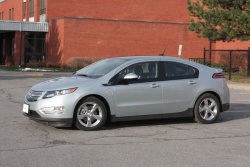 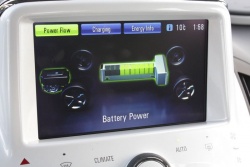 2012 Chevrolet Volt. Click image to enlarge |
In preparation for this trip, we charged the Volt overnight using the standard 110V charge cord. With no rain forecast, we used an outside outlet, but protected the charge cord just in case.
In the morning, with a full charge, we were somewhat surprised to see that its range as an EV was only 46 km. The Volt’s electric-only range is advertised as 40-80 km, and presumably the 46 km number was based on the driving history of this particular car, which had 10,400 km on the odometer.
However, 46.9 km is what we achieved before the Volt switched to gasoline, and after that, it operated similarly to a conventional hybrid, with the car’s regenerative braking charging the battery, which assisted the gasoline engine. A power flow graphic shows you this process in action, but remember, the gasoline engine never directly powers the wheels.
In extended range mode, the Volt is not as quiet. The 1.4-litre, four-cylinder engine emits a mild hum in the background, and on occasion whirrs audibly as it works to generate electricity for the battery. It’s not objectionable, but seems a little incongruous. operation isn’t linear like it is in a conventional car, where the engine note rises and falls in time with the car’s speed. Therefore, the gas powerplant might “idle” high when the car is stopped, and then purr along nearly imperceptibly when the car is at speed.
Our speed on a combination of secondary and multi-lane highways ranged between 90-115 km/h, and en route we found the driver’s seat very comfortable and supportive, and were impressed with the design of the interior and its fit and finish.
Speed is not the order of the day either. The Volt is about as quick in a straight line as a typical subcompact car; 149 horsepower (from the electric motor) and a curb weight of more than 1,700 kg (3,781 lbs) will do that. What makes it feel quicker than it is, at least at first, is lack of noise. When running on electricity, hard acceleration from a stop generates some quiet whirring and whining noises; the only familiar sound is the tire noise that ramps up as the car gains speed. One thing that takes getting used to, and that we hadn’t expected, is the lack of a racing engine note to indicate that the front wheels are spinning in slippery conditions.
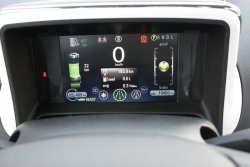 2012 Chevrolet Volt. Click image to enlarge |
Once back in Ottawa, we ran the battery down on two occasions; both times, we travelled a little more than 40 kilometres before it went flat and the engine had to start. Even with the engine as a backup, driving this car makes you acutely aware of how far you travel; it becomes a bit of a game to see how much distance you can cover on a full charge. In city driving, according to the Volt’s trip computer, we burned a total of 0.6 litres of gasoline, for a fuel consumption average of 0.32 L/100 km. Our actual energy consumption rate was higher than that, of course, but we figure our four days of driving cost about $5 in gasoline and electricity costs. On our highway trip, the vehicle returned 5.5 L/100 km, after 460 highway kilometres, and including the 46.9 km from the battery. A fill-up cost $26.00.
Getting a full charge into an exhausted battery took eight to 10 hours using the 120-volt charging unit supplied with the car; a 220-volt charging dock installed at your home will shorten that time to about four hours.
 2012 Chevrolet Volt. Click image to enlarge |
This is a four-seat, hatchback (or liftback) car, and with the rear seats folded, the Volt has excellent cargo capacity. We transported a car hood and other parts without issue.
The instrument panel (or really, display panel) consists of two displays that contain an abundance of information on the status of the car. In front of the driver is a digital speedometer, fuel and charge meters, along with other vehicle operating data. This display is customizable. The touch-screen display at the top of the centre stack moves through navigation, power flow, audio, climate, and communications at the press of a button.
Below the centre display is a sea of buttons and lights that duplicate most of the touch-screen items on the display. We found ourselves wishing that the touch-screen display had “sweep” technology like an Apple iPad, so you could just sweep through the various screens.
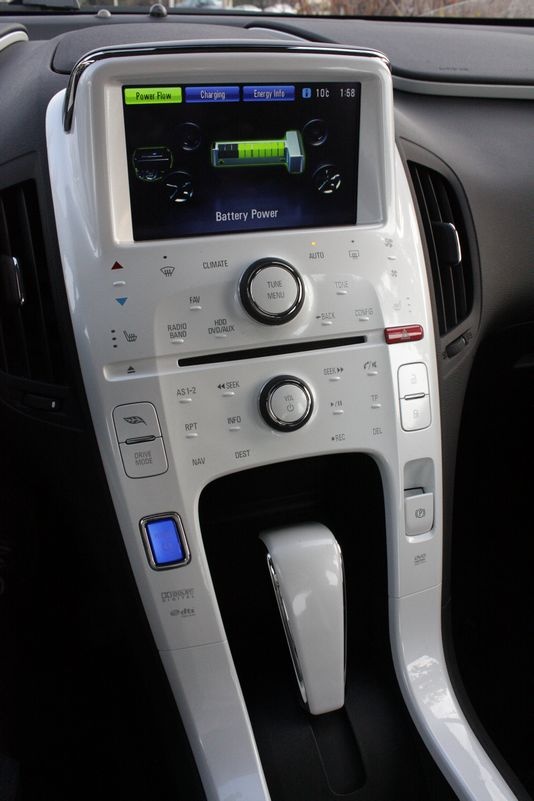 2012 Chevrolet Volt. Click image to enlarge |
Although this car was fully optioned, one thing that’s not available is a rear-view camera. It would seem an obvious feature to include as standard equipment, as outward visibility at the rear is compromised by the smallish rear window and the large frame of the liftback.
Otherwise, driving the Volt on a long trip was similar to driving most cars, albeit stylish and hi-tech ones.
The Volt, a compact car based on the Cruze, is no bargain, starting at $41,545. Add the $6,000 worth of options in our test car, including navigation, premium stereo, 17-inch wheels and upgraded paint ($1,135!), and you boost the price to $48,150. The all-electric Nissan Leaf costs $38,995 and includes navigation; the package that adds that option to the Volt costs $2,300 on its own. Comparing base prices, you’re paying about $2,500 for the Volt’s “range-extending” drivetrain but that cost is probably higher once you start factoring in what convenience items are standard in each car.
Consider, too, that for buyers fixated on value for the dollar, there’s a veritable fleet of small cars that cost less than half what the Volt does, come with nearly as much kit and whose real-world, highway fuel consumption figures rival those of the Volt once you’ve gone beyond where its battery can take you. For a certain buyer, the Volt, with all of its avant-garde technology, is worth whatever Chevrolet wants to charge for it. In absolute terms, though, it’s a terrible financial proposition, unless you do most of your driving in the city and rarely light up the gas engine. At that point, though, a bicycle for the summertime and a transit pass for the winter is a smarter financial proposition.
 2012 Chevrolet Volt. Click image to enlarge |
The Volt’s fuel consumption is terrific, but don’t forget, if fuel economy is your primary concern, a 2012 Volkswagen Passat TDI promises to use as little as 4.5 L/100 km on the same highway trip, and you can buy one of those for just over $27,000.
And then there’s the “plugging in” aspect of Volt ownership. You’ve got to be diligent with this; no getting home after a long day at work and putting off plugging in your Volt in favour of crashing on your couch. If plugging and unplugging your Volt starts to become a chore to avoid, you’ve kind of defeated the purpose of buying one.
In town, GM says the cost of electricity to power the Volt will be between one-quarter and one-sixth the cost of gasoline, so there will be real savings to be had locally. On the highway, if you’re in the Volt for a lot of longer trips, its fuel economy is excellent, but there are equivalent alternatives for less upfront cost.
We’re car guys, but these days, we’re more impressed by envelope-pushing cars like the Volt than by big horsepower and sticky handling. That stuff’s fun, but it’s been done to death. That said, though the Chevrolet Volt is an intriguing car, for some reason EVs and hybrids – even cool ones like the Volt — are more interesting than exciting. Car enthusiasts would probably opt for something less cerebral; more emotional. It’s the demise of decibels, we guess.
|
Pricing: 2012 Chevrolet Volt
|











